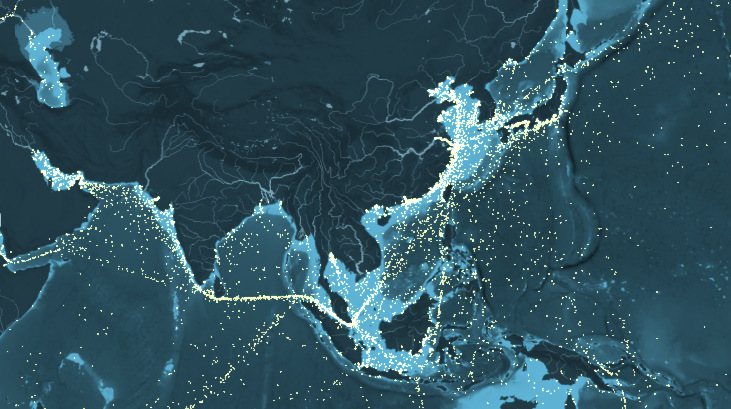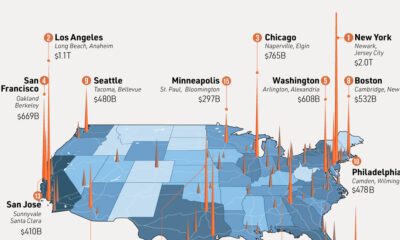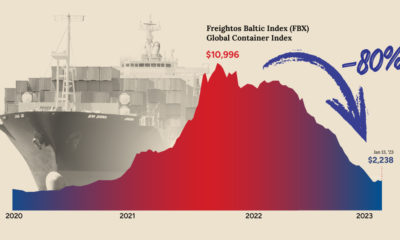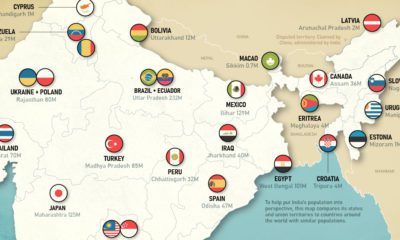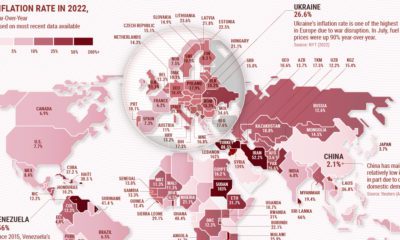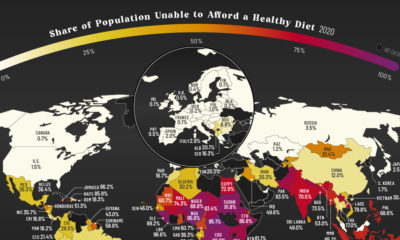Misc
Mapped: Global Shipping Routes, Using 250 Million Data Points
How busy are the world’s shipping routes, and where are the global chokepoints for commercial shipping?
Today’s visualization compiles 250 million data points, representing the movement of the world’s commercial shipping fleet based on hourly data from 2012.
The interactive map below breaks up the merchant fleet into five ship types: container ships, dry bulk carriers, oil and fuel ships, gas ships, and carriers transporting vehicles.
The interactive map was created by data visualization outfit Kiln, along with the UCL Energy Institute. It counts emitted CO2 (in thousands of tonnes) as well as the running total of the maximum freight carried by each type of vessel. The map that the data is plotted on is also bathymetric, which means it uses shading to convey the depth of the ocean at any given point.
The more this map is explored, the more it rewards the viewer. The first thing a viewer may notice is the difference between the relatively quiet seas surrounding North and South America to the busy shipping routes nearby Europe, India, Southeast Asia, and especially China.
It’s also worth following the ships that go up some of the world’s biggest rivers. How do you get goods to Moscow? Through the Black Sea and up the Volga River. On the other side of Asia is the Yangtze River in China, which is loaded with ships from Shanghai all the way to Nanjing.
To cap it off, check out the global shipping chokepoints, where you can observe thousands of ships passing through the world’s tightest and most dangerous thoroughfares such as the Panama Canal, The Bosphorus (Istanbul, Turkey), the Strait of Hormuz, or the Strait of Dover (in the narrowest point of the English Channel). For the polar opposite effect, look off the coast of Somalia, were piracy is rampant and commercial ships venture at their own risk.
VC+
VC+: Get Our Key Takeaways From the IMF’s World Economic Outlook
A sneak preview of the exclusive VC+ Special Dispatch—your shortcut to understanding IMF’s World Economic Outlook report.

Have you read IMF’s latest World Economic Outlook yet? At a daunting 202 pages, we don’t blame you if it’s still on your to-do list.
But don’t worry, you don’t need to read the whole April release, because we’ve already done the hard work for you.
To save you time and effort, the Visual Capitalist team has compiled a visual analysis of everything you need to know from the report—and our upcoming VC+ Special Dispatch will be available exclusively to VC+ members on Thursday, April 25th.
If you’re not already subscribed to VC+, make sure you sign up now to receive the full analysis of the IMF report, and more (we release similar deep dives every week).
For now, here’s what VC+ members can expect to receive.
Your Shortcut to Understanding IMF’s World Economic Outlook
With long and short-term growth prospects declining for many countries around the world, this Special Dispatch offers a visual analysis of the key figures and takeaways from the IMF’s report including:
- The global decline in economic growth forecasts
- Real GDP growth and inflation forecasts for major nations in 2024
- When interest rate cuts will happen and interest rate forecasts
- How debt-to-GDP ratios have changed since 2000
- And much more!
Get the Full Breakdown in the Next VC+ Special Dispatch
VC+ members will receive the full Special Dispatch on Thursday, April 25th.
Make sure you join VC+ now to receive exclusive charts and the full analysis of key takeaways from IMF’s World Economic Outlook.
Don’t miss out. Become a VC+ member today.
What You Get When You Become a VC+ Member
VC+ is Visual Capitalist’s premium subscription. As a member, you’ll get the following:
- Special Dispatches: Deep dive visual briefings on crucial reports and global trends
- Markets This Month: A snappy summary of the state of the markets and what to look out for
- The Trendline: Weekly curation of the best visualizations from across the globe
- Global Forecast Series: Our flagship annual report that covers everything you need to know related to the economy, markets, geopolitics, and the latest tech trends
- VC+ Archive: Hundreds of previously released VC+ briefings and reports that you’ve been missing out on, all in one dedicated hub
You can get all of the above, and more, by joining VC+ today.
-

 Markets1 week ago
Markets1 week agoU.S. Debt Interest Payments Reach $1 Trillion
-

 Business2 weeks ago
Business2 weeks agoCharted: Big Four Market Share by S&P 500 Audits
-

 Real Estate2 weeks ago
Real Estate2 weeks agoRanked: The Most Valuable Housing Markets in America
-

 Money2 weeks ago
Money2 weeks agoWhich States Have the Highest Minimum Wage in America?
-

 AI2 weeks ago
AI2 weeks agoRanked: Semiconductor Companies by Industry Revenue Share
-

 Markets2 weeks ago
Markets2 weeks agoRanked: The World’s Top Flight Routes, by Revenue
-

 Demographics2 weeks ago
Demographics2 weeks agoPopulation Projections: The World’s 6 Largest Countries in 2075
-

 Markets2 weeks ago
Markets2 weeks agoThe Top 10 States by Real GDP Growth in 2023

